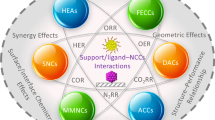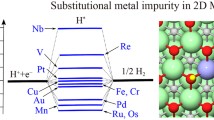Abstract
Metallic subnanoparticles deposited over supports such as TiO2 play an important role for the design of model catalysts for heterogeneous catalysis applications. In this work we study the structure and energetic of Pt13 clusters deposited on TiO2(110) surfaces, using an ab initio DFT + U modeling method. We first examine the structural and dynamical stability of the isolated Pt13 nanoclusters by considering as initial configurations symmetrical Ih and Oh structures and new layered isomers. We determine their equilibrium geometries, cohesive energies, magnetic moments, electronic and vibrational density of states. The analysis of the vibrational modes reveal that the Oh and Ih structures are dynamically unstable unlike the layered structures that have lower energies. We then examine the Pt13-titania system to characterize the cluster/substrate interaction for both the stoichiometric and reduced surfaces. We characterize different aspects of the metal-oxide interaction by determining their equilibrium geometries, adsorption energies, charge transfer effects and electronic density of states. We find that the Pt13 cluster suffers a strong restructuration when adsorbed on the surface, it deforms towards increasing the interaction of the platinum atoms with the surface, leading to a high value of the adsorption energy and getting oxidized. The Pt13-rutile system is semiconductor; for the stoichiometric system a localized state in the band gap is predicted. The calculated surface oxygen vacancy formation energy is prefered by the cluster deposition as a fact that favours the use of this system in the CO oxidation reactions from a surface oxygen, an important step in the water gas shift reaction.











Similar content being viewed by others
References
Bagheri S, Julkapli MN, Hamid BAS (2014) Titanium dioxide as a catalyst support in heterogeneous catalysis. Sci World J. https://doi.org/10.1155/2014/727496
Sun Y-M, Belton DN, White JM (1986) Characteristics of Pt thin films on TiO2(110). J Phys Chem 90:5178–5182
Bonanni S, Aït-Mansour K, Brune H, Harbich W (2011) Overcoming the strong metal-support interaction state: CO oxidation on TiO2(110)-supported Pt nanoclusters. ACS Catal 1:385–389
Bonanni S, Aït-Mansour K, Harbich W, Brune H (2014) Reaction-induced cluster ripening and initial size-dependent reaction rates for CO oxidation on Ptn/TiO2(110)-(1 × 1). J Am Chem Soc 13:8702–8707
Andreeva D, Idakiev V, Tabakova T, Ilieva L, Falaras P, Bourlinos A (2002) Low-temperature water-gas shift reaction over Au/CeO2 catalysts. Catal Today 72:51–57
Ammal S, Heyden A (2011) Nature of Ptn/TiO2(110) (n = 1-8) interface under water-gas shift reaction conditions: a constrained ab initio thermodynamics study. J Phys Chem C 115:19246
Ammal S, Heyden A (2013) Origin of the unique activity of Pt/TiO2 catalysts for the water–gas shift reaction. J Catal 306:78–90
Jiang D, Overbury SH, Dai S (2012) Structures and energetics of Pt clusters on TiO2: interplay between metal-metal bonds and metal-oxygen bonds. J Phys Chem C 116:21880–21885
Celik V, Ünal H, Mete E, Ellialtoglu S (2010) Theoretical analysis of small Pt particles on rutile TiO2(110) surfaces. Phys Rev B 82:205113
Paz-Borbón LO, López-Martinez A, Garzón IL, Posada-Amarillas A, Grönbeck H (2017) 2D–3D structural transition in sub-nanometer Pt N clusters supported on CeO 2 (111). Phys Chem Chem Phys 19:17845–17855
Xiao L, Wang L (2004) Structures of platinum clusters: planar or spherical? J Phys Chem A 108:8605–8614
Wang L, Johnson DD (2007) Density functional study of structural trends for late-transition-metal 13-atom clusters. Phys Rev B 75:235405–235410
Bhattacharyya K, Majumder Ch (2007) Growth pattern and bonding trends in Ptn (n = 2–13) clusters: theoretical investigation based on first principle calculations. Chem Phys Lett 446:374–379
Maldonado AS, Cabeza GF, Ramos SB (2019) Dynamical stability and vibrational properties of Pt clusters. J Phys Chem Solids 131:131–138
Sauceda HE, Pelayo JJ, Salazar F, Pérez LA, Garzón IL (2013) Vibrational spectrum, caloric curve, low-temperature heat capacity, and debye temperature of sodium clusters: the Na139 + case. J Phys Chem C 117:11393–11398
Sauceda HE, Garzón IL (2015) Structural determination of metal nanoparticles from their vibrational (phonon) density of states. J Phys Chem C 119:10876–10880
Schierbaum KD, Fischer S, Torquemada MC, de Segovia JL, Román E, Martin-Gago JA (1996) The interaction of Pt with TiO2(110) surfaces: a comparative XPS, UPS, ISS, and ESD study. Surf Sci 345:261–273
Çakır C, Gülseren O (2012) Adsorption of Pt and bimetallic PtAu clusters on the partially reduced rutile (110) TiO2 surface: a first-principles study. J Phys Chem C 116:5735–5746
Isomura N, Wu X, Watanabe Y (2009) Atomic-resolution imaging of size-selected platinum clusters on TiO2(110) surfaces. J Chem Phys 131:164707
Watanabe Y, Wu X, Hirata H, Isomura N (2011) Size-dependent catalytic activity and geometries of size-selected Pt clusters on TiO2(110) surfaces. Catal Sci Technol 1:1490–1495
Madsen GKH, Hammer BJ (2009) Effect of subsurface Ti-interstitials on the bonding of small gold clusters on rutile. J Chem Phys 130:044704–044707
Chretien S, Metiu HJ (2008) O2 evolution on a clean partially reduced rutile TiO2(110) surface and on the same surface precovered with Au1 and Au2: the importance of spin conservation. J Chem Phys 129:074705–074716
Ruiz-Martinez J, Sepulveda-Escribano A, Anderson JA, Rodriguez-Reinoso F (2009) Spectroscopic and microcalorimetric study of a TiO2-supported platinum catalyst. Phys Chem Chem Phys 11:917–920
Maldonado AS, Morgade CIN, Ramos SB, Cabeza GF (2017) Comparative study of CO adsorption on planar and tetrahedral Pt nanoclusters supported on TiO2(110) stoichiometric and reduced surfaces. J Mol Catal A 433C:403–413
Vilhelmsen LB, Hammer B (2014) A genetic algorithm for first principles global structure optimization of supported nano structures. J Chem Phys 141:044711
Barcaro G, Fortunelli A (2007) Magic silver cluster on a MgO (100) terrace with defects. Phys Rev B 76:165412–165416
Davis JBA, Horswell SL, Johnston RL (2016) Application of a parallel genetic algorithm to the global optimization of gas-phase and supported gold–iridium sub-nanoalloys. J Phys Chem 120:3759
Kresse G, Hafner J (1993) Ab Initio molecular dynamics for liquid metals. Phys Rev B 47:558–561
Kresse G, Hafner J (1993) Ab Initio molecular dynamics for open-shell transition metals. Phys Rev B 48:13115–13118
Kresse G, Hafner J (1994) Ab Initio molecular-dynamics simulation of the liquid-metal–amorphous-semiconductor transition in germanium. Phys Rev B 49:14251–14269
Blöchl P (1994) Projector augmented-wave method. Phys Rev B 50:17953–17979
Perdew JP, Chevary JA, Vosko SH, Jackson KA, Pederson MR, Singh DJ, Fiolhais C (1992) Atoms, molecules, solids, and surfaces: applications of the generalized gradient approximation for exchange and correlation. Phys Rev B 46:6671–6687
Perdew JP, Chevary JA, Vosko SH, Jackson KA, Pederson MR, Singh DJ, Fiolhais C (1993) Erratum: donor transition energy in GaAs superlattices in a magnetic field along the growth axis. Phys Rev B 48:4978
Dudarev S, Botton G, Savrasov S, Humphreys C, Sutton A (1998) Electron-energy-loss spectra and the structural stability of nickel oxide: an LSDA + U study. Phys Rev B 57:1505–1509
Anisimov VI, Zaanen J, Andersen OK (1991) Band theory and Mott insulators: hubbard U instead of Stoner I. Phys Rev B 44:943–954
Morgade CIN (2015) Study of the properties of modified TiO2 as a support for catalytic reactions. Ph.D. Thesis, Universidad Nacional del Sur, Physics Department
Bader RFW (1990) Atoms in molecules: a quantum theory. Oxford University Press, Oxford
Huda MN, Niranjan K, Sahu BR, Kleinman L (2006) Effect of spin-orbit coupling on small platinum nanoclusters. Phys Rev A 73:053201
Błonski P, Hafner J (2011) Magneto-structural properties and magnetic anisotropy of small transition-metal clusters: a first-principles study. J Phys: Condens Matter 23:136001–136020
Togo A, Tanaka I (2015) First principles phonon calculations in materials science. Scr Mater 108:1–5
Berry H, Wang B, Zhang Q (2018) The behavior of magnetic properties in the clusters of 4d transition metals. Molecules 23:1896
Shafai G, Ortigoza MA, Rahman TS (2012) Vibrations of Au13 and FeAu12 nanoparticles and the limits of the Debye temperature concept. J Phys: Condens Matter 24:104026–104029
Alcántara Ortigoza M, Heid R, Bohnen KP, Rahman TS (2014) Anomalously soft and stiff modes of transition-metal nanoparticles. J Phys Chem C 118:10335–10347
Acknowledgements
The authors thank the financial support from Consejo Nacional de Investigaciones Científicas y Técnicas (CONICET) under Project PIP 112-20110100814, Universidad Nacional del Sur (UNS) (PGI: 24/F068) and Universidad Nacional del Comahue (Project I238), Argentina.
Author information
Authors and Affiliations
Corresponding author
Additional information
Publisher's Note
Springer Nature remains neutral with regard to jurisdictional claims in published maps and institutional affiliations.
Electronic Supplementary Material
Below is the link to the electronic supplementary material.
Supplementary material 1 (WMV 8333 kb)
Rights and permissions
About this article
Cite this article
Maldonado, A.S., Ramos, S.B. & Cabeza, G.F. Properties of Isolated and TiO2(110) Supported Pt13 Clusters: A Theoretical Study. Top Catal 62, 989–1003 (2019). https://doi.org/10.1007/s11244-019-01182-1
Published:
Issue Date:
DOI: https://doi.org/10.1007/s11244-019-01182-1




